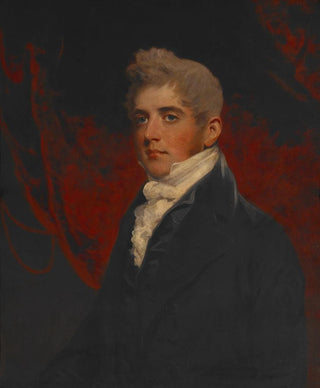Art print | Portrait of William Inigo Jones - John Hoppner


View from behind

Frame (optional)
William Inigo Jones Portrait - John Hoppner – Engaging Introduction
The "Portrait of William Inigo Jones" by John Hoppner is much more than a simple depiction of a man; it is a window into an era, a reflection of the aspirations and values of a rapidly changing world. Created at the end of the 18th century, this painting embodies the essence of British art during a period when neoclassicism and romanticism began to intertwine. Hoppner, through his undeniable talent, manages to capture not only the physical appearance of his subject but also his character and spirit. The work invites viewers to reflect on Jones's role in society of his time, while offering a rich and immersive visual experience.
Style and uniqueness of the work
Hoppner's style is distinguished by his ability to combine realism and idealization. In this portrait, William Inigo Jones's features are rendered with a precision that demonstrates meticulous observation. The interplay of light and shadow, skillfully orchestrated, adds depth to the piece, while the chosen color palette evokes a certain human warmth. The detailed clothing, carefully painted, are not merely fashion elements but symbols of status and culture. This painting transcends a simple portrait by becoming a psychological study, where each exchanged glance between the subject and the viewer seems loaded with meaning. Hoppner thus succeeds in immortalizing the very essence of his model, while offering an artistic vision that continues to fascinate.
The artist and his influence
John Hoppner, born in 1758, is one of the most renowned portraitists of his time. His career, marked by a rapid rise within the London artistic society, testifies to his exceptional talent and his ability to capture the spirit of the age. Influenced by masters such as Reynolds and Gainsborough, Hoppner develops a distinctive style that combines technical finesse and emotional sensitivity. His work is not limited to portraits of eminent figures but also extends to more intimate representations, revealing his versatility. Through his portraits, Hoppner contributed to shaping the image of the aristocracy

Matte finish

View from behind

Frame (optional)
William Inigo Jones Portrait - John Hoppner – Engaging Introduction
The "Portrait of William Inigo Jones" by John Hoppner is much more than a simple depiction of a man; it is a window into an era, a reflection of the aspirations and values of a rapidly changing world. Created at the end of the 18th century, this painting embodies the essence of British art during a period when neoclassicism and romanticism began to intertwine. Hoppner, through his undeniable talent, manages to capture not only the physical appearance of his subject but also his character and spirit. The work invites viewers to reflect on Jones's role in society of his time, while offering a rich and immersive visual experience.
Style and uniqueness of the work
Hoppner's style is distinguished by his ability to combine realism and idealization. In this portrait, William Inigo Jones's features are rendered with a precision that demonstrates meticulous observation. The interplay of light and shadow, skillfully orchestrated, adds depth to the piece, while the chosen color palette evokes a certain human warmth. The detailed clothing, carefully painted, are not merely fashion elements but symbols of status and culture. This painting transcends a simple portrait by becoming a psychological study, where each exchanged glance between the subject and the viewer seems loaded with meaning. Hoppner thus succeeds in immortalizing the very essence of his model, while offering an artistic vision that continues to fascinate.
The artist and his influence
John Hoppner, born in 1758, is one of the most renowned portraitists of his time. His career, marked by a rapid rise within the London artistic society, testifies to his exceptional talent and his ability to capture the spirit of the age. Influenced by masters such as Reynolds and Gainsborough, Hoppner develops a distinctive style that combines technical finesse and emotional sensitivity. His work is not limited to portraits of eminent figures but also extends to more intimate representations, revealing his versatility. Through his portraits, Hoppner contributed to shaping the image of the aristocracy






